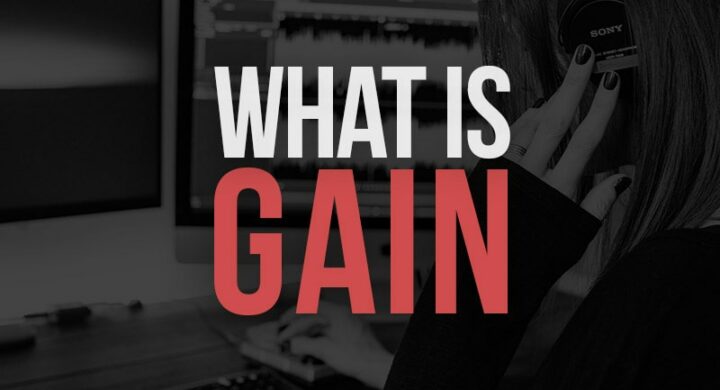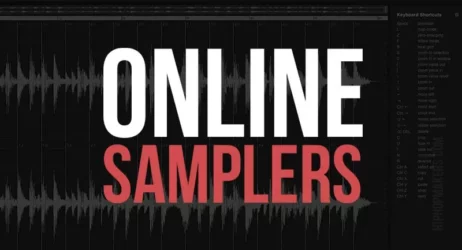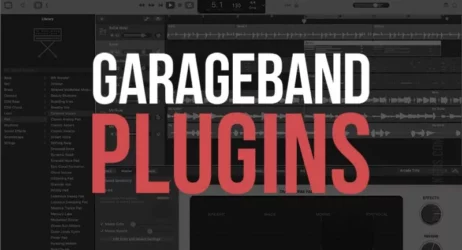This quick guide will answer what is Gain in audio, how to properly use it, and explain its differences from volume. Explore the basics of audio gain.
- What is Gain in Audio
- Is Gain Good For Audio
- Should The Gain Be High Or Low
- Where Should The Gain Be Set At
- How Do You Balance Gain & Volume?
- Audio Gain Overview
What is Gain in Audio?
Gain is the unit of measurement for the loudness of an audio source, which is usually measured in decibels (dB). Gain refers to how much the audio input has gained from being amplified. The goal of adjusting gain is to balance too much noise and not enough volume for the best results.
In simple words, Gain is the amount an amplifier increases the audio signal.
It is important to note that amps have two stages. The first gain stage is the preamp stage, and the second is the power amp stage.

So how it works is when you plug in your guitar, the signals from it reach the preamp, where the preamp boosts the signal path. After that, the preamp transfers the signal to the second stage, the power amp, which gets boosted further and made loud.
Your gain knob is associated with the preamp, while the volume knob is associated with the power amp.
The volume knob makes your overall sound huge, and the gain knob will also make it louder. However, it’s not like the volume knob.
The volume knob does a massive change to the volume of the sound, while the gain knob will make it a little bit bigger.
The gain knob plays more role in shaping your tone. So as you boost that preamp, it goes from the cleaner to a more distorted kind of sound.
But when you keep your Gain steady and increase the volume, you can hear the louder output volume, but it won’t get distorted. Just with the increase in volume, you would keep hearing it louder.
So the Gain, although it can make the sound louder, actually shapes the tone, gives it more distortion. On the other hand, the volume takes whatever is given to it (whether it’s a high gain or low Gain) and makes that louder.
You can keep the volume low or adjust the Gain to get the sound you want. You can also keep your gain steady but adjust the volume to see the difference in the loudness.
You can start with your Gain at first, get the overall sound whether you want clean, distorted, or somewhere between. Choose that and dial that on the Gain.
After that, you can adjust your volume to make the sound just louder or softer. This is how you can get the sound and tone that you want.
Gain controls the volume of the audio signal before it passes through mixing and recording devices. On the other hand, when we say volume, we mean the final output level of the speakers, headphones, etc.
Is Gain Good For Audio?
Gain is used for getting a good audio input level. The purpose of Gain is to normalize the amount of audio signal coming from the device plugged into the mixer. If all the instruments and vocals sent out the same signal level, it would be nice, but they don’t, which is exactly why Gain exists.
To understand more about the Gain, you can imagine that the cable that connects an instrument to the mixer is a water hose. Where you plug in that cable into your mixer is a valve, kind of like a water faucet.
Now when the Gain is turned down, the valve is closed. The more you turn up the gain, the more the valve opens, letting more signals pass through to the mixer.
All the instruments and vocals send out a different signal flow, and the audio gain input will regulate the flow. So that everything is the same as it travels through the rest of your mixer.
In other words, the Gain is the front door to your mixer, and that is why it’s so important to get it right because it’s going to affect everything else down the line.
Should The Gain Be High Or Low?
It depends on how you would want your sound to be. You can set the Gain too high if you want to have a more distorted sound, especially considering the guitar amp.
But if you want a cleaner sound, then you can set the Gain too low.
Guitarists generally turn the Gain high deliberately to get the nice distorted sound from the tube preamp.
With your gain being up while the volume is low, you can get that distorted kind of sound without annoying anyone in your neighborhood. But if you keep the Gain low and volume high, you would get a loud sound without any distortion.
Where Should The Gain Be Set At?
You’ll need to do this for every instrument and vocal, but it’s really easy once you know what you’re looking for.
While the instrument is playing or the vocalist is singing, you can adjust the Gain levels until the meter next to the gain knob consistently hits the first couple of orange or yellow lights.
We’re talking about that negative 18 dB mark on some mixers, and other mixers may have this mark at 0 dB. Either way, you’re looking to always be crawling over the point on your mixer where the green lights meet that orange or yellow light.
Note that there will probably be times when you’re hitting more yellow and orange lights. Especially during the louder moments.
But on average, all your channels should hang out right there where the green meets the yellow, and that’s it.
How Do You Balance Gain & Volume?
Now keep this in mind when setting Gain. It doesn’t matter where the fader is for that channel. You can even set the Gain level while a channel is muted because both the fader and the mute button do not affect Gain.
Finally, make it a habit to set the Gain at the beginning of every rehearsal, and it’s not something that you can set once and then never look at it again.
Things change, and remember, Gain is not a volume control, and it’s the front door to your mixer.
The goal is to use audio gain to get everything operating at the same level before entering the audio mixer.
This may seem small, but getting the gain levels right is essential to create a great audio mix.
Audio Gain Overview
A gain is a unit of measurement that indicates how loud an audio source is. Decibels (dB) are usually used to measure volume, and it refers to the amount of gain that the audio signal has achieved after being amplified.
When adjusting gain, you aim to find the right balance between too much noise and not enough volume for the best results.
It’s imperative to understand the critical role of gain and volume in an audio system. The term gain refers to the adjustment of the input signal level coming from our instrument signals, such as a guitar amplifier, into an audio interface.
On the other hand, volume is more about the output stage, which is what we perceive as the loudness of the sound system.
These two are important distinctions often mixed up by many beginners in the audio production world. Gain control, also known as makeup gain control, is an essential process in the initial input stage of our audio interfaces.
It ensures the correct signal level, providing a clean tone and preventing unwanted distortion in our tracks. Meanwhile, volume is about the mix bus, or stereo bus, which happens later in the signal chain, specifically in the mixing console.
With the help of plug-ins and digital audio technology, the same concept of gain works by setting the input volume at the right level before it reaches the mix bus. This setting is crucial to maintain sound quality and preserve the integrity of our sound in the audio environment.
Proper gain staging is an important practice in audio production. In this digital music creation world, the input volume of all the tracks needs to be correctly set, allowing enough room for the mixing process.
This procedure aids in maintaining a low noise floor ratio and a high signal-to-noise ratio, which is critical for good sound quality.
Understanding how to manage gain control using your audio interface or analog gear, such as a guitar amplifier, from the input stage through the gain stage to the output stage is crucial. Whether in the audio recording realm or live sound, this knowledge ensures a well-balanced and clean sound system that does justice to your music.
Remember, every component in the signal chain, from the audio interface to the VU meter on a mixing console, plays a role in the overall sound quality.
The correct gain adjustment and proper use of the makeup gain control can significantly prevent clipping and unwanted distortion.
In conclusion, the gain setting isn’t about making your sound louder; it’s about managing the signal level effectively and preventing issues in the later stages of your audio system.
As I’ve navigated through the intricacies of the digital era, it’s clear that correctly setting gain and understanding how gain works is pivotal in achieving a high-quality sound.
Ultimately, the goal is to provide a well-balanced mix with excellent sound quality, which will reflect well on your overall audio production.
I hope you found this information on audio gain helpful.




